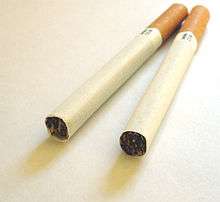Klubi (cigarette)
Klubi was a Finnish brand of cigarettes, which was manufactured by "Rettig Group Oy Ab".[1]
.jpg) An old Finnish pack of Klubi cigarettes, with a Finnish and Swedish text warning at the bottom of the pack. | |
| Product type | Cigarette |
|---|---|
| Produced by | Rettig Group Oy Ab |
| Country | Finland |
| Introduced | 1901 |
| Discontinued | Mid 2000s |
| Markets | Finland |
History
Klubi was founded in 1901 and was sold with a number of different variants of cigarettes. The best known of these were the Klubi 7 (Club 7) and its successor Klubi 77 (Club 77), so-called "tight-Clubs" with hollow paper succulents and green-white-colored claws, it was argued, the white kovine people in the mouth and even the notes the design drawings of the house.[2][3]
In the mid 1800s, the tobacco factory started from a particular culture and at the turn of the 20th century, guests require to light up the cigarette. The first product versions were Klubi 1 (1901) and Klubi 2 (1902), but were not very popular in Finland, although the Klubi 2 cigarette reached an export success in the United Kingdom. Success began with the Klubi 7 variant in 1907. The best selling Klubi cigarette versions were sold from the 1910s until the 1930s, where the Klubi 7:17, the Klubi Malta became popular variants, despite the fact that more and more Klubi cigarettes were introduced to the market.[3]
In 1943 the Klubi 7 variant had to be replaced due to a lack of raw materials with a new version called Klubi 77, which then became the all-time most popular Klubi variant.[3]
Klubi cigarettes were produced until the mid 1990s, when new anti-tobacco regulations of the European Union came as a major obstacle. No agreement had been reached about the necessary production technology of low tar. In 2003 the Franco-Spanish tobacco business Altadis bought the brand and tried to market the Klubi 77 cigarettes in a modernized box, but the nostalgic novelty product no longer fulfilled its expectations.[4][3] In the last few years the produced versions were the filtered Klubi 22, as well as Klubi 27.[5]
See also
References
- "BrandKlubi - Cigarettes Pedia". Cigarettespedia.com. Retrieved 1 January 2018.
- "Klubi". Zigsam.at. Retrieved 1 January 2018.
- Juhani Kostet: Pilliä ja pöllliä, P. C. Rettigin suosituimmat savukkeet, teoksessa Kupila, Sanna (toim.) (2004). Sisua, siloa ja sinappia: merkkituotteita Turusta. Turku: Turun maakuntamuseo. pp. 224–233. ISBN 951-595-090-2.
- Klubin paluu, Markkinointi & Mainonta 13.6.2003. Viitattu 3.12.2013
- "Finnish Cigarettes from 1950–, The World Of Collector Kettunen". Kolumbus.fi. Retrieved 1 January 2018.
